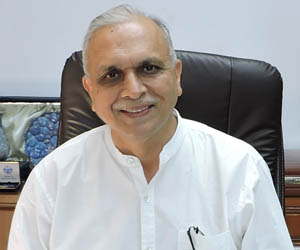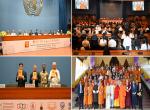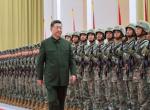President Trump’s unorthodox policies and announcements have made the global situation highly intricate and uncertain. With the imposition of unilateral tariffs against Canada, Mexico and China, the prospect of a severe global trade war has become real. Even otherwise, the global economic and trading system is fragmenting with the rise in protectionism. The ongoing Russia-Ukraine war, the weaponisation of global financial systems, disruption of supply chains have had adverse consequences for most countries. India is not immune to the growing geopolitical tensions and their geo-economic consequences.
In a refreshing trend that has been visible for the last couple of years, the Government of India’s annual Economic Survey for 2024-25 devotes considerable space to geopolitics and geoeconomics. A notable feature of this year’s Survey is that it establishes a clear link between the economic growth outlook for India and geopolitical and geo-economic factors.
The key point made in the survey is that the Indian economy is facing several geopolitical headwinds, which are not in its control. With globalisation on the retreat, India will have to find ways to sustain its long-term economic growth through domestic growth drivers
It is necessary to understand the nature and scope of these constraints to arrive at a realistic understanding of the environment in which the Indian economy will grow in the next few years.
The 2023-24 Economic Survey triggered a vigorous debate in the strategic circle on the desirability or otherwise of Chinese investments and their security implications for India. This year’s survey takes the discussion forward. It lists in considerable detail the impact of Chinese dominance in manufacturing and how it affects the global economy.
The broad global economic trends are easy to identify. Global economic growth is at around 3 percent is almost stagnant. Protectionism is taking its toll on global trade which is slowing down. China is facing deflationary trends due to overcapacity and the problems in its real estate sector. The leading economies of Europe, like Germany, are stagnant or facing recessionary pressures due to high energy costs following the disruption of cheap energy from Russia. The US debt is at all time high and yet the US dollar has strengthened against all major currencies. The stock markets are ignoring the global problems and remain expensive.
What are the features of the present geo-political environment, which would affect India’s economic prospects?
Geopolitical Risks
The world is witnessing simultaneous conflicts in different parts, especially in Europe and West Asia. The Survey points out that the tensions in the Middle East have already interrupted critical shipping routes, which has led to higher insurance premiums and higher freight rates due to diversion of shipping routes. It cites the Geopolitical Economic Policy Uncertainty Index, and the World Trade Uncertainty Index to emphasise that trade tensions and policy shifts in major economies have created significant uncertainty in global trade in recent months. The ongoing conflicts continue to cloud the global economic outlook.
Economic Fragmentation
The Survey notes that trade fragmentation is reshaping the global economy. According to certain economic models quoted in the Survey, “the cost to global output from trade fragmentation could range from 0.2 percent up to 7 percent of the (global) GDP”. The European Union’s restrictive trade policies in the name of climate change will affect India’s exports to the region and widen the current account deficit. This comes at a time when “the FDI into India is declining” and foreign investors lured by incentives given by other governments have made “successful exit”.
Energy Transition
Energy transition is the focus of this year's Economic Survey. It underlines the need for energy security and energy affordability without which no economic growth is possible. The energy scenario in the world is changing rapidly due to a combination of factors like the ongoing push for energy transition to net zero, the volatility in the energy markets due to the Russia-Ukraine war and the supply chain disruptions. India’s dependence on imports of energy makes it vulnerable to these factors. India will need an assured and increasing supply of energy to power its economic growth. The Survey emphasises that India needs to find its “own path to energy transition and diversification away from fossil fuels…” It underlines that solar and wind energy does not come cheap. “The higher dependence on intermittent sources of power results in higher energy costs”. Solar and wind energy require massive storage capabilities and are not suitable for transmission grid stability. Storage batteries are costly, environmentally unfriendly, and require mining and processing of material at large scale. This point is often overlooked in energy transition discourse. Solar and wind energy is still immature and not in a position to replace fossil fuels as a source of energy in the near future. Thus, a hurried push towards renewable energy is not the answer. The Survey points to an interesting paradox. The greater the push for renewable energy sources, the greater is the demand for renewable energy, and the greater is the consumption of coal in China which holds the near monopoly over processing of critical minerals and rare earths that are needed for clean energy.
China’s Dominance
China’s dominance in global trade and manufacturing has skewed the global environment. No country can avoid dependence on Chinese manufacturers. As the Survey points out, China will account for nearly 45 percent of global industrial production in 2030 as compared to 6 percent in 2000. Even the entire world united would not be able to ‘defeat China’ in industrial manufacturing. China’s dominance is felt in several sectors, particularly electric vehicles, critical minerals and clean energy equipment. About 60 percent of global wind energy capacity is sourced from China. About 80 percent of photovoltaic cells and their components are made in China. Nearly 70 percent of rare earth minerals that are needed for high-storage batteries are processed in China. China has a dominant position globally in lithium-ion batteries. It is indispensable for the global push towards clean energy. The Survey warns, “Economic realignments and readjustments are imminent. The rise of China as a manufacturing powerhouse and its impact on the manufacturing aspirations of other nations, as well as the supply of minerals, materials, machinery, and equipment needed for energy transition, pose challenges”
Artificial Intelligence
Artificial intelligence is set to transform the global geopolitics and geoeconomics. It creates both challenges and opportunities. India will have to manage the rise of Artificial Intelligence in the context of its impact on labour and workplace. The Survey points out, “Past technology revolutions, when not carefully managed, have been painful with long-lasting adverse impacts”. AI is not benign. It will require huge investments in data centre and computational resources. It can also potentially replace labour which will have adverse consequences for India. The Survey emphasises that managing AI and harnessing its potential will require strategic approach and coordinated efforts between the government, and academia, robust institutions, and reliable applications. Presently, AI applications are biased and of uneven quality. India will need to create its own large language models but this would entail high-energy consumption and external dependency (on China) for critical minerals, hardware and finance. Thus, the AI trajectory for India is not straightforward and full of pitfalls.
The Economic Survey is a comprehensive document that looks at the Indian economic outlook in the medium term in a realistic way. Overall, the messages is positive. India has maintained a decadal growth rate of above 6 percent. But it is essential to achieve 8 percent growth for the next two decades to realise the dream of Viksit Bharat by 2047. The ‘China challenge’ is real. The external environment is becoming adverse due to economic fragmentation, ongoing conflicts and excessive dependence on China. India will have to take all steps to reduce these vulnerabilities to the extent possible and build indigenous strengths. Equally, it will have to find domestic growth drivers to sustain high economic growth.
The Survey makes several suggestions. Taking a long-term strategic view, the private sector should invest in domestic supply chain and build resilience. The country should focus on adaptation measures to fight climate change. The costs and benefits of clean energy and AI should be properly assessed. Energy transition is going to be disruptive. We have to manage it carefully. There is as yet no viable alternative to coal in energy generation. Deregulation and improving the ease of doing business is the way forward.
(The paper is the author’s individual scholastic articulation. The author certifies that the article/paper is original in content, unpublished and it has not been submitted for publication/web upload elsewhere, and that the facts and figures quoted are duly referenced, as needed, and are believed to be correct). (The paper does not necessarily represent the organisational stance... More >>
Image Source: https://www.thehindubusinessline.com/economy/economic-survey-2025-highlights/article69162398.ece











Post new comment